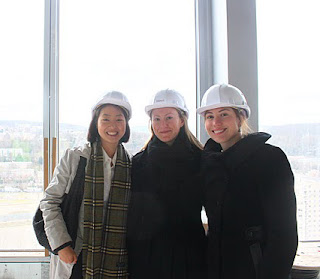
On Friday we visited the Morgan Stanley offices in the Central Business District. The building was located in a Parisian
hôtel-particulier, in which the
corps de logis (main building) is separated from the street by an interior courtyard. We were welcomed by a team who had worked with Professor Schaefer, when she was head of asset management for Morgan Stanley based in London. The Morgan Stanley team prepared a presentation on the state of the European CRE debt market. German banks over the past 2-3 years have been active, providing most liquidity in real estate. Specifically due to the German Pfandbreif market, which has remained an efficient funding source. For the large part, banks are getting back to the "bricks-and-mortar"of underwriting criteria: strong cash flows, strong covenants, maturity of leases, historical vacancy, location location, replacement cost, and state of maintenance (recent and projected capital expenditure). The interest rate environment has softened significantly; long and short term rates are at historical lows. In 2007 we saw yields on property drop lower than risk-free rates on 10-year bond. While property yields have climbed back up and the spread is as wide as ever, financing is less attractive. There is 550-600 BN of European CMBS that will mature in 2013, which will bring about sales and foreclosure. However, the foreclosure process can take longer in Europe than in the US.
After the presentation, and for the first time this trip, we explained our investment thesis to the Morgan Stanley team. Overall, they agreed with our conclusion: that French real estate market was too competitive for US pension fund capital seeking opportunistic returns. We agreed that when 2005-06 debt matures over the next 2-3 years there will be more investment opportunities. We then went on to discuss the state of the Eurozone and how France is less exposed to the sovereign debt crisis than other European countries. Too wrap up, we enjoyed a less formal conversation with the Co-Head of Global Real Estate the Investment Banking Division of Morgan Stanley about defining a career path. He then asked each student what had surprised them most about our trip to France. Some responses:
- How different the market was from 5-10 years ago
- The amount of government regulation
- The Parisian real estate market has proven less volatile than other European cities
- The lack of refurbished property in prime market locations
- How difficult it is to source off-market deals, even with a local team
- The amount of languages European real estate professionals are required to speak
All this took place in a conference room that overlooked gardens landscaped in the typical french style. We sipped espresso and pastries, as the conversation extended beyond the scheduled meeting time.
 |
| France MSRED on step of Morgan Stanley |
 |
| Pallav (group photographer) in entrance to the street |





































